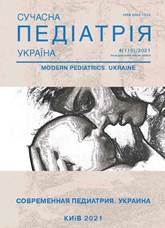Comorbidity of bronchial asthma and allergic rhinitis in its alternative course in school-age children
DOI:
https://doi.org/10.15574/SP.2021.116.19Keywords:
bronchial asthma, allergic rhinitis, childrenAbstract
The study of the comorbidity of bronchial asthma (BA) and allergic rhinitis (AR) in children will expand the understanding of the pathogenetic mechanisms of the most trending childhood allergic diseases.
Purpose — to investigate some clinical and paraclinical features of AR in its alternative course in schoolchildren for the optimization of the personalized antiinflammatory therapy of patients with comorbidity of BA and AR.
Materials and methods. A comprehensive clinical and paraclinical examination of 66 of school-age children with BA with concomitant AR has beenperformed. Depending on the course of AR, patients have been divided into 2 groups: group I — 34 children with BA and intermittent AR (mean age — 13.4±0.8 years, the proportion of boys — 70.5%), group II — 32 asthma patients, which have signs of persistent AR (mean age — 12.1±1.1 years) (p>0.05), the proportion of boys — 81.2% (p>0.05). The diagnosis of BA and AR was established according to the modern requirements. All children underwent a study of bronchial lability by assessing their response to dosed exercise and inhalation of short-acting β2-adrenomimetics (200 mcg salbutamol) followed by calculation of bronchial lability, considered as the sum of its components — indicies of bronchospasm and bronchodilation.
Results. Patients with persistent allergic rhinitis have had a more severe and less controlled course of bronchial asthma with a 3.0-fold increased risk. The baseline spirographic examination has showed that patients with intermittent allergic rhinitis were three times more likely to have FEV1<80% and the higher chances of marked airway lability at the level of small bronchi, including by forced midexpiratory flow rate as well.
Conclusions. The comorbid course of bronchial asthma and intermittent allergic rhinitis in children was accompanied by a lower chance of uncontrolled asrhma, along with a higher probability of developing nonspecific airway hyperreactivity.
The research was carried out in accordance with the principles of the Helsinki Declaration. The study protocol was approved by the Local Ethics Committee of all participating institution. The informed consent of the patient was obtained for conducting the studies.
No conflict of interest was declared by the authors.
References
Blondal V, Sundbom F, Borres MP, Hogman M, Alving K, Malinovschi A, Janson C. (2020). Study of atopic multimorbidity in subjects with rhinitis using multiplex allergen component analysis. Clin Transl Allergy. 10: 6-11. https://doi.org/10.1186/s13601-020-0311-6; PMid:32110380 PMCid:PMC7033937
Buslau A, Voss S, Herrmann E, Schubert R, Zielen S, Schulze J. (2014). Can we predict allergen-induced asthma in patients with allergic rhinitis? Clin Exp Allergy. 44: 1494-1502. https://doi.org/10.1111/cea.12427; PMid:25270425
Ciprandi G, Tosca VA, Signori A, Cirillo I. (2018). Bronchial hyperreactivity in patients with allergic rhinitis: Forced expiratory flow between 25 and 75% of vital capacity might be a predictive factor. Allergy and Asthma Proceedings. 32 (2): 4-8. https://doi.org/10.2500/aap.2011.32.3425; PMid:21439158
Global Initiative for Asthma. (2019). Pocket Guide for Asthma Management and Prevention: 36.
Hovland V, Riiser A, Mowinckel P, Carlsen KH, Lodrup KC. (2014). Asthma with allergic comorbidities in adolescence is associated with bronchial responsiveness and airways inflammation. Pediatr. Allergy Immunol. 25: 351-359. https://doi.org/10.1111/pai.12241; PMid:24953295
Jean Bousquet, Holger J Schunemann, Akdis Togias, Claus Bachert, Martina Erhola, Peter W Hellings, Ludger Klimek, Oliver Pfaar, Dana Wallace, Ignacio Ansotegui, Ioana Agache, Anna Bedbrook, Karl-Christian Bergmann, Mike Bewick, Philippe Bonniaud, Sinthia Bosnic-Anticevich, Isabelle Bosse, Jacques Bouchard, Louis-Philippe Boulet et al. (2020, Jan). Next-generation Allergic Rhinitis and Its Impact on Asthma (ARIA) guidelines for allergic rhinitis based on Grading of Recommendations Assessment, Development and Evaluation (GRADE) and real-world evidence (updated 2020). J Allergy Clin Immunol. 145 (1): 70-80.
Koinis-Mitchell D, Esteban C, Kopel SJ, Jandasek B, Dansereau K, Fritz GK, Klein RB. (2013). Perceptual accuracy of upper airway compromise in children: Clinical relevance and future directions for research. Allergy Rhinol (Providence). 4 (2): 54-62. https://doi.org/10.2500/ar.2013.4.0060; PMid:24124637 PMCid:PMC3793113
Luthra M, Bist SS, Mishra S, Bharti B, Aggarwal V, Monga U. (2019). Evaluation of Association of Allergic Rhinitis with Bronchial Asthma. Indian J. Otolaryngol. Head Neck Surg. 71 (3): 1687-1691. https://doi.org/10.1007/s12070-015-0931-7; PMid:31763225 PMCid:PMC6848355
Novyk HA, Borychev AV. (2007). Spyrometryia y pykfloumetryia pry bronkhyalnoi astme u detei (praktyka otsenky y monytorynha). SPb: HPMA: 68.
Saranz RJ, Lozano A, Lozano NA, Ponzio MF, Cruz AA. (2017). Subclinical lower airways correlates of chronic allergic and non-allergic rhinitis. Clin Exp Allergy. 47: 988-997. https://doi.org/10.1111/cea.12938; PMid:28421631
Schramm D, Reuter M, Grabenhenrich LB. (2018). What does lung function tell us about respiratory multimorbidity in childhood and early adulthood? Results from the MAS birth cohort study. Pediatr Allergy Immunol. 29: 481-489. https://doi.org/10.1111/pai.12901; PMid:29604118
Yan Z, Liu L, Jiao L, Wen X, Liu J, Wang N. (2020). Bioinformatics Analysis and Identification of Underlying Biomarkers Potentially Linking Allergic Rhinitis and Asthma. Med Sci Monit. 26: 924-934. https://doi.org/10.12659/MSM.924934
Downloads
Published
Issue
Section
License
Copyright (c) 2021 Modern Pediatrics. Ukraine

This work is licensed under a Creative Commons Attribution-NonCommercial 4.0 International License.
The policy of the Journal “MODERN PEDIATRICS. UKRAINE” is compatible with the vast majority of funders' of open access and self-archiving policies. The journal provides immediate open access route being convinced that everyone – not only scientists - can benefit from research results, and publishes articles exclusively under open access distribution, with a Creative Commons Attribution-Noncommercial 4.0 international license (СС BY-NC).
Authors transfer the copyright to the Journal “MODERN PEDIATRICS. UKRAINE” when the manuscript is accepted for publication. Authors declare that this manuscript has not been published nor is under simultaneous consideration for publication elsewhere. After publication, the articles become freely available on-line to the public.
Readers have the right to use, distribute, and reproduce articles in any medium, provided the articles and the journal are properly cited.
The use of published materials for commercial purposes is strongly prohibited.

